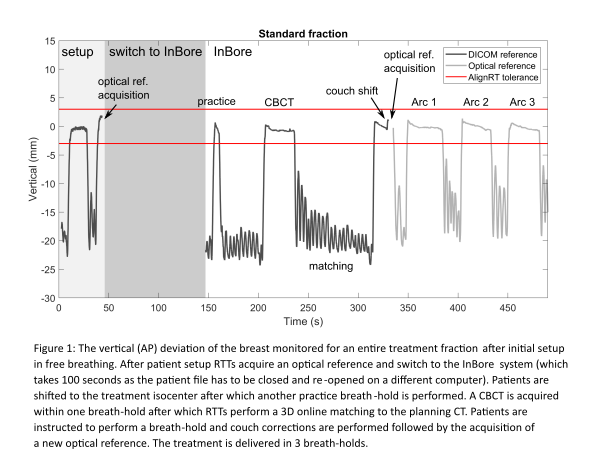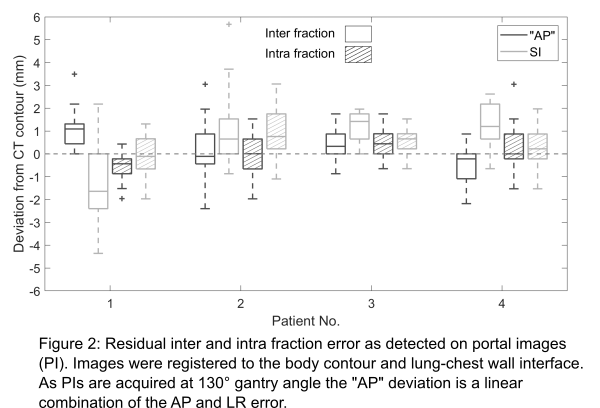In-bore surface guided DIBH breast VMAT treatments in a closed-bore linac
Laurence Delombaerde,
Belgium
PO-1694
Abstract
In-bore surface guided DIBH breast VMAT treatments in a closed-bore linac
Authors: Laurence Delombaerde1,2, Saskia Petillion2, Caroline Weltens1,2, Tom Depuydt1,2
1KU Leuven, Department of Oncology, Leuven, Belgium; 2UZ Leuven, Department of Radiation Oncology, Leuven, Belgium
Show Affiliations
Hide Affiliations
Purpose or Objective
An
in-bore surface scanning system to monitor patients in the closed-bore linac
Halcyon (Varian Medical Systems) has recently become available, AlignRT InBore
(VisionRT Ltd.). We treated 4 patients in deep-inspiration breath-hold (DIBH)
and assessed inter and intra fraction motion and workflow efficiency.
Material and Methods
Four
left-sided breast cancer patients were treated in DIBH on Halcyon using a
triple partial arc VMAT technique with simultaneous integrated boost (SIB) for
21 fractions. Setup was performed with the ceiling mounted AlignRT system and
patients were shifted into the Halcyon bore. A manual switch to the AlignRT
InBore system was required for our research system. At the treatment isocenter,
AlignRT InBore monitored the breast surface and patients performed
video-coached breath-holds, figure 1. Delivery was manually interrupted when
the patients left the breath-hold window (± 3mm, 3°). Portal images were acquired during
delivery using framegrabber hardware and software (iTools, Varian Medical
Systems) at gantry angle 130°. Inter fraction, intra fraction and intra-breath-hold
motion were extracted from surface, CBCT and portal image data. The efficiency
of the surface guided workflow was assessed by collecting setup time, time at
the isocenter and total fraction duration from both AlignRT as Record and
Verify timestamp information.
Results
A
total of 64 complete fractions were available for analysis. Inter fraction
systematic (Σ) and random (σ) setup errors were Σ =1.0mm, σ =1.2 mm
for the AP, Σ =1.3mm, σ =1.8 mm for the SI and Σ =1.1mm, σ =1.7 mm for the LR axis. The mean intra fraction
errors were 0.0 ± 1.0
mm for the “AP” axis (linear combination of the AP and LR component) and 0.4 ± 1.0
mm for the SI axis as detected on portal images, see figure 2. Intra-breath-hold
motion was limited to median 1 mm for the AP, 1.3mm for the SI and 0.6 mm for
the LR axis. Median
total fraction duration was 10 min 1 sec which includes a mean 2 minutes of
idle time (figure 1) to switch from the patient setup to the InBore AlignRT
system. A median 5 min 15 sec was spent at the treatment isocenter (including
CBCT acquisition, position verification and VMAT delivery). 92% of all fractions
were completed in 4 breath-holds of mean 25 sec duration.


Conclusion
Full surface guided DIBH workflows using
both AlignRT for patient setup as AlignRT InBore on the Halcyon linac proved efficient with
good inter and intra fraction reproducibility.